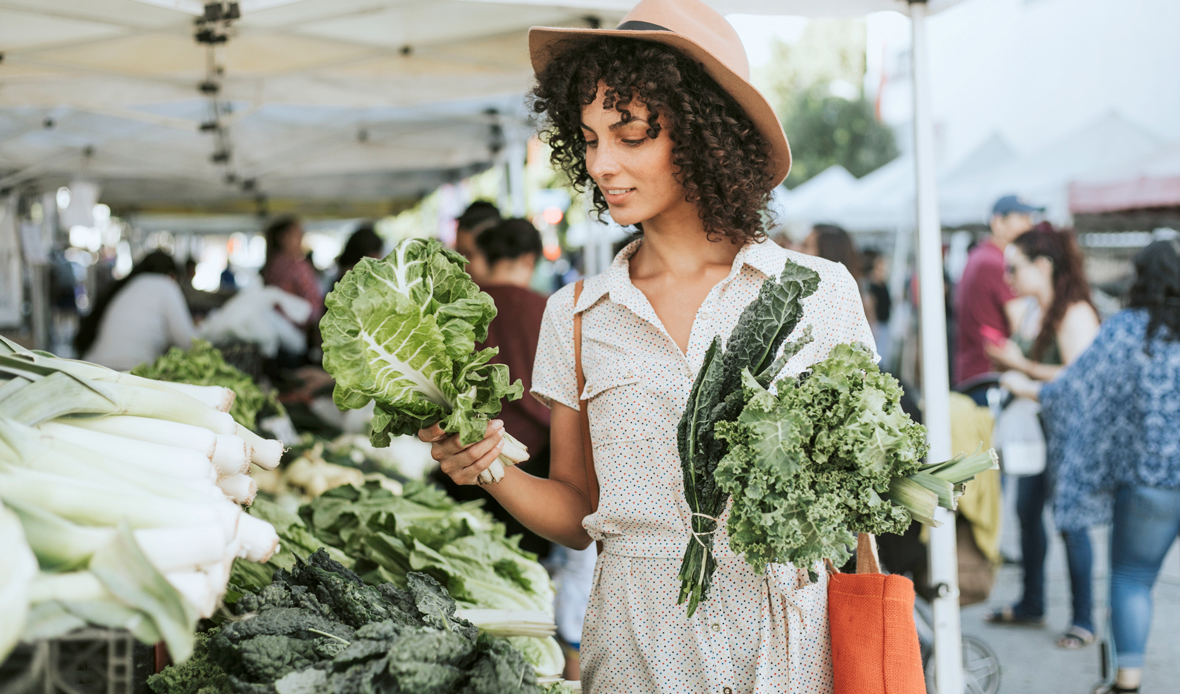
Colorful vegetables stacked in overflowing piles, jars of locally made honey and maple syrup glistening in the sun, and bunches of fresh flowers begging to be brought home. Farmers’ markets make the chore of shopping for groceries into an adventure. Plus they promote eating seasonal, fresh fruits and veggies that have been recently picked—giving them a higher nutrient content and more intense flavor than what you’d find in most produce sections.
Whether you’re new to the market or have been hitting the stands for years, these tips can help you make the most of your visit.
1. Gather info first, online and in person. Start your research online—you can find hours, schedules, and any special protocols still in place for social distancing. Most markets have an information booth where you can find out about special services or events, or locate restrooms and ask additional questions.
2. Arrive early…or late. If you’re one of the first to arrive on the scene, you benefit from having the pick of the crop—and avoiding crowds. This is especially important if, say, you want to buy a bushel of tomatoes for canning or a special variety of lettuce that tends to sell out. On the other hand, showing up toward the end of the selling day means you may benefit from lower prices as vendors look to clear their stalls for the day.
3. Plan for the week ahead. Being surrounded by heaps of gorgeous vegetables and locally-raised meat and poultry can be overwhelming and lead to impulse buying. Instead, plan your meals in advance, just as you would when visiting the grocery store. Do a little research on what’s in season as you make your meal plan and include items that may be available at the market. Create a separate list of pantry items to pick up at the store.
4. Leave room for living in the moment. While most of your shopping may be intentional, do allow yourself to indulge in fun new discoveries, exceptionally fine produce, or irresistible small-batch goodies. One of the most exciting things about the farmers’ market is that it’s not completely predictable.
5. Take a lap before you buy. Many of the vendors carry similar items, so before you buy a pound of green beans at the first stall, take your time and walk the market to compare offerings. Check out the different varieties available and compare prices. This can help you find the best quality and the best deals.
6. BYOB (Bring your own bags). At the farmers’ market you’ll not only stock up on healthy food, but you can also get your steps in! Be prepared by choosing sturdy bags that are comfortable to carry. Canvas bags that you can sling over the shoulder, backpacks, or even a small cart are all good solutions. Vendors often supply bags, but they are usually thin plastic bags that are uncomfortable to carry, and not great for the environment either.
7. Chat up the farmers and vendors. One of the greatest things about shopping at a farmers’ market is, well, farmers! You can ask any questions you have about the food they are selling. What is this thing? Is it organic? Heirloom? Can I substitute this veggie for the one I usually include in a stir-fry? What does this taste like? How should I prepare this? Be respectful of the fact that they are working, but also take advantage of their knowledge and availability.
8. Like a good avocado, prices are usually firm. Unlike a flea market or garage sale, the prices at farmers’ markets are set and haggling isn’t usually part of the picture. Prices are typically posted clearly on the table. It is, however, fair game to ask if there’s a bulk discount.
9. Know the preferred payment method. For many years, it was recommended to come ready with a stack of small bills. Recently, COVID-19 and the increasing ease of mobile payment methods have made card payments a more popular option in the market. Some farmers’ markets have tokens or cards you can purchase with a credit card and use in place of cash at the market. Check out the website or visit the information booth to find out the best way to pay.
10. Buy gorgeous, ripe, in-season food and enjoy it. Ideally, look for brightly colored, unblemished produce in the second or third week of harvest. Wash all produce thoroughly just before you prepare it. When it comes to meat, seek out lean cuts with no additives. As you prepare and eat the food you’ve bought, try to incorporate a mindful awareness of its color, flavor, and textures. Savor and enjoy.
Work on your nutrition goals with one-to-one support from a MOBE Guide. Get started today.